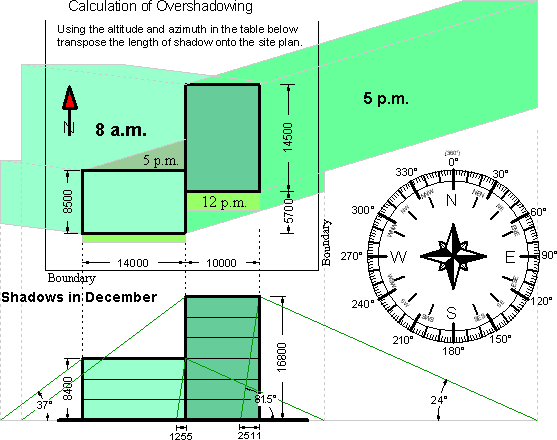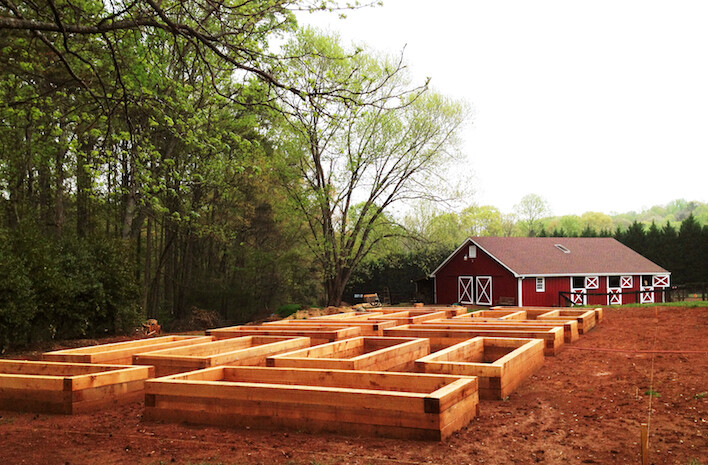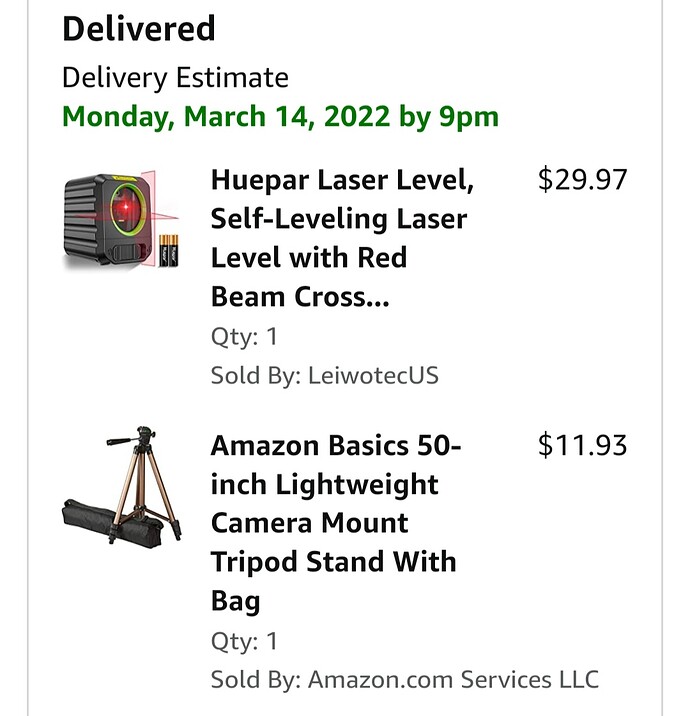I am starting a brand new raised bed garden, but this time, I want the beds even with each other and in relation to the house. How do I do this??? I am missing some key skill and my last garden beds were not even. Is there a survey technique (and do you have links to instruction or video). I have a really good compass. I want them to look like this (NOT my garden, alas, but see how even they are?)
Laser level and a marked stick to make bottoms and all level and the same height
Youre going to need some string, stakes and a level/ laser level (as you can see in the picture you posted). Focus on leveling the ground first and not the beds. Get the ground where you want it to be and the beds will be much easier to level. Do your best but even if they are a little off you will still have the same amount of success as if they were all perfectly even. Good luck and post pictures of what your finished results are!
Use a line level with nylon string and wooden stakes to establish a reference height across the project area. Then, dig and fill as appropriate until the distance from ground to reference line is the same everywhere. Just make a square around the perimeter, and have another bit of line that’s tied on one of your stakes that you can swing over your area and check for level. Instead of using a ruler, have a stick or stake marked with your target ground to line distance, so you can check your height at a glance. If you want to really be sure, check for level on the ground with the longest level you can find. But you’ll probably be close enough that you won’t have to worry about that.
One handy trick for leveling, if you don’t have a laser level (worth renting, if you can):
Take a hose full of water and attach one end to a bed which is already at an acceptable level. The other end of the hose will flow if it is too low. You’ll want a shut off valve on each end, and it’s really handy to have a good helper while you’re doing this.
Also remember that when you’re laying out a square or rectangle that you can use the Pythagorean theorem to check it:
The advice everyone gave you is good advice i’m going to elaborate. While most things are up in price during the pandemic other things are not and your in luck! I got them more for leveling pictures on the walls or building solar racks but they will work for raised beds. You will also need a level and a square and spend the time planning it out.
If your beds are very large and cover more than the distance of the laser beams it changes to a two person job. When we built my Ponds we shot them with a transit to set the spillway at the right level. Borrowed a friend and his transit.
Things like these are nice to have
So finally set 4 - 12 blocks of wood in the ground about 3 feet tall depending on size and pound them in the ground. I would use 2x4’s with one end cut to a point. Once you shoot the 2x4’s level with the laser mark them. Let’s say you want all beds 2 foot off the ground mark 2 feet on the 2x4’s that might be 18" on one and 30" on the other to level them up. Finally when your done with the laser take strings and run them from each mark on the 2x4 to the other making it all square and level. It’s important to run string around the outside of the square but also across the middle. Your middle strings better be equal in length. Imagine that’s 9 beds.
From time to time check with your level make sure you are not accidently getting out of line. A straight 2x4 with a 2 foot level on top will help you level the dirt which is a trick concrete workers use frequently.
Feeling like a pro yet? They eventually make investments like this which I don’t recommend for your job.
Having perfect level beds would probably look great… but would they perform the best ?

Having a few beds with a 10-15 degree slope to the south could make a big difference in crops like greens, carrots, even tomatoes getting a early start or hanging in there later in the season.
I could not find any details on this but I expect that a 10-15 degree slope to the south, would change your Zone 6 to 7 (something like that).
My fig is planted on the south side of my house, just off a tall red brick wall that faces the south, and the ground there slopes at 15 - 20 degrees to the south. Ideal…microclimate location.
By the way those are some very nice looking raised beds. Looks like you are going to have plenty of room to grow lots of food. Best of luck !
TNHunter
Wow! Great information on getting the beds level and at the same height as each other!!! Thank you! Any thoughts on how to get the sides parallel or perpendicular to the sides of the house, so they visually work with the area, and are square with each other? I figure you must set up two strings, but how do you make sure the strings are at a 90 degree angle? And not off kilter from the sides of the house?
The surveyor who did your house set pins at the property line which are straight. The road is a boarder and so are your property lines. Let’s say your fence is where that true surveyors marks are at. Measure the distance to your house from that pin and to the road and then the other side set up a grid as mark mention making sure to follow the theorem when you align the grid. If you want to stay straight as mentioned a laser or transit will do it all depending on how much distance you want to go. If you want to get more technical you can which is setting things by GPS coordinates. Everything follows latitude and longitude. I’ve described some of that here https://growingfruit.org/t/reading-the-sky-to-tell-time-time-of-year-and-direction/40354
So everyone’s house and property has a description let’s say yours is in the nw quarter they will even give your principal meridian Principal meridian - Wikipedia. The fact you know precisely where your borders are and they are true means with a laser which has a level in it means there is no way whatever you shoot your laser or transit at isn’t a straight line. You know your points already Line (geometry) - Wikipedia and the laser or transit makes sure you stay within those lines. "The Pythagorean theorem is one of the most famous equations, as it helps us to relate the angle and sides of a right triangle.
And as we know, a right triangle is comprised of two legs ( a and b below) and a hypotenuse (c below).
The hypotenuse is the longest side and is always opposite to the right angle."

@marknmt Ah!! Yes! I was still thinking about leveling and missed this. This is what I was looking for, for the squaring the area!! I still haven’t used the calculus that I learned in high school (17-year-old me: when am I ever going to need this???), but I sure have used geometry!
I’m not sure the lay of your property. “An acre is a unit of measure for area. One acre ie equal to 43,560 square feet. Often, an acre is a rectangle that measures 660 feet by 66 feet. However, the length and width of the rectangle can vary. An acre can actually have any shape, as long as it measures exactly 43,560 square feet.” Let’s say your property is 1 acre and and it is 660 x 66 which is unlikely you can see how that’s your rectangle. So lets say your 30 feet from your house to the fence that will be a straight line if you shoot it with a laser and the laser is straight and level. So therefore the same is true when you shoot from the fence to the garden bed or house to garden bed or other fence. If your property is 1000 acres the same rules apply.
I swear, of all the math I learned (through modern college algebra as a sophomore) the most useful has been the Pythagorean theorem! But make it easy on yourself: use a laser level as @clarkinks and @etheth32992 and @Carlin described. That way you can avoid sloppy hoses and measurements with strings that stretch and so on.
i just used a reg level placed across the corners of the beds and shimmed with cedar shingles till level. not as high tech but it worked and was quick. like others said, make sure your ground is fairly level before you place the beds. good luck!
If anyone wants to know more and your not just making garden beds there is much more to know about geometry, algebra, trigonometry, calculus and all the things they said you would never use in life. Life can get as complicated as you want it to be. Let’s say @Bellatrix asked not only how to align the beds but then wanted to know how much dirt its going to take or if the slope is 7 degrees more on half the beds and decides to raise all the area 7 degrees before making the beds how much dirt do you order? This is why we have engineers design complexed projects or architects design complexed buidings or surveyors verify land borders are set according to the deed the zoning and planning office has.
Here is a cool link with concepts you might find useful in some way. This is why sun dials were pretty good at telling time or as I’ve mentioned the sky is accurate for navigation. These angles allow us to calculate other things. Let’s say you were at the equator there is no shadow but the further you are away at a given time the shadow degrees change. So technically measuring the shadow doesn’t just tell time it also gives distance. Shadow angles

Eratosthenes calculated the earth’s size around 240 BC using sticks and shadows . Earth’s circumference can be calculated by measuring the shadows cast by any pair of sunlit vertical structures a known distance apart. A stick and another point are all that is needed. So if you placed a stick at the equator it’s 0 degrees at say noon then you walk 100 miles and measure the shadow at noon you can calculate distance around the planet based on those 2 angles. Longitude and latitude are used nowadays but the concept is similar
" Program for distance between two points on earth
- Difficulty Level : Medium
- Last Updated : 09 Apr, 2021
Given latitude and longitude in degrees find the distance between two points on the earth.

Image Source : Wikipedia
Examples:
Input : Latitude 1: 53.32055555555556 Latitude 2: 53.31861111111111 Longitude 1: -1.7297222222222221 Longitude 2: -1.6997222222222223 Output: Distance is: 2.0043678382716137 Kilometers
Recommended: Please try your approach on {IDE} first, before moving on to the solution.
Problem can be solved using Haversine formula:
The great circle distance or the orthodromic distance is the shortest distance between two points on a sphere (or the surface of Earth). In order to use this method, we need to have the co-ordinates of point A and point B.The great circle method is chosen over other methods.
First, convert the latitude and longitude values from decimal degrees to radians. For this divide the values of longitude and latitude of both the points by 180/pi. The value of pi is 22/7. The value of 180/pi is approximately 57.29577951. If we want to calculate the distance between two places in miles, use the value 3, 963, which is the radius of Earth. If we want to calculate the distance between two places in kilometers, use the value 6, 378.8, which is the radius of Earth.
Find the value of the latitude in radians:
Value of Latitude in Radians, lat = Latitude / (180/pi) OR
Value of Latitude in Radians, lat = Latitude / 57.29577951
Find the value of longitude in radians:
Value of Longitude in Radians, long = Longitude / (180/pi) OR
Value of Longitude in Radians, long = Longitude / 57.29577951
Get the co-ordinates of point A in terms of latitude and longitude. Use the above conversion method to convert the values of latitude and longitude in radians. I will call it as lat1 and long1. Do the same for the co-ordinates of Point B and get lat2 and long2.
Now, to get the distance between point A and point B use the following formula:
Distance, d = 3963.0 * arccos[(sin(lat1) * sin(lat2)) + cos(lat1) * cos(lat2) * cos(long2 – long1)]
The obtained distance, d, is in miles. If you want your value to be in units of kilometers, multiple d by 1.609344.
d in kilometers = 1.609344 * d in miles
Thus you can have the shortest distance between two places on Earth using the great circle distance approach."Program for distance between two points on earth - GeeksforGeeks
Computer programmers do much of this for people because people make mistakes on calculations https://python.plainenglish.io/calculating-great-circle-distances-in-python-cf98f64c1ea0
I’m going to go back to the garden beds now
All you guys are way smarter than me so I don’t have any technical advice to add to what has already been given, but just had to remark about how beautiful your raised beds look!
I’m with you. I’m confused now. I have a couple of basic levels I use and that’ll be it for me. LOL
When raising beds to be even with one another remember than any beds sitting right on the ground will eventually “leak” garden soil into the pathways. Much better if you can cut shallow trenches that the beds can nest in.
Sadly, they are not mine! They are just an example of someone else’s beds that I found very aesthetically pleasing!
@clarkinks That is an amazing summary! Sine! Cosine! It is all coming back (OK, slowly, it was a VERY long time ago). I am constantly amazed at what a knowledgable group of gardening people are in this forum! It is awesome! Hands on knowledge to complex mathematics 
yep. math’s not my strong suit. but im not a perfectionist. like to keep things simple.







